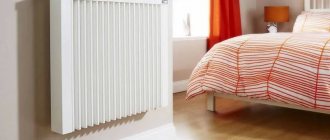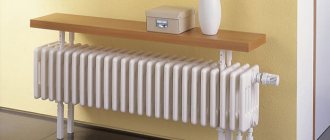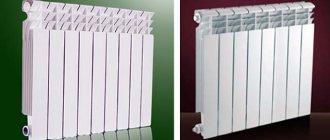Features of choosing a coolant
If centralized networks are used to heat residential, industrial and office premises, then the choice of batteries is carried out in accordance with the indicators of the working environment. For autonomous systems of private houses and country cottages, the coolant for radiators is selected taking into account its compatibility with heating devices and operating efficiency. In this case, you need to pay attention to the following parameters of the working environment circulating through the pipeline:
- viscosity level;
- freezing temperature;
- heat transfer and heat capacity indicators;
- safety in use.
An important factor is the activity of the coolant in relation to the battery material, which is determined by its composition.
Useful tips
Which coolant should you choose – water or antifreeze? This depends on many factors, including the likelihood and duration of a power outage in a private home, frequency of residence, climate and others.
For example, if electricity works stably, you should choose water as the coolant, and simply supplement the communications with an uninterruptible power supply.
Before pouring the mixture into the heating circuit, you need to check whether its components precipitate. If such a phenomenon occurs, it is worth diluting it with distilled water, but not more than 50%, otherwise the anti-corrosion characteristics will decrease. New antifreeze is added to the heating system of a private home every 5-6 years.
It is impossible to say unequivocally about the need for antifreeze liquid. Antifreeze will definitely not be superfluous if the residents leave the house in winter, and the communications are equipped with a tee water supply system, where the liquid is drained with the onset of cold weather. However, the best advice on the compatibility of a specific boiler model with an anti-freeze system will be given to you by the manufacturer of the heating device.
Comparison of working environment parameters of different types
| Characteristics | Unit change | Water | Antifreeze |
| Heat capacity | kJ/(kg*K) | 4,19 | 3,5-3,7 |
| Thermal conductivity at 20 °C | W/m*K | 0,605 | 0,433 |
| Density | g/cm3 | 0,998 | 1,04-1,075 |
| Prone to corrosion | There is activity | No activity | |
| Hazard Class | 5 safe | 3-4 moderately hazardous substance | |
| Viscosity | mm2/s | 1,002 | 5,8-7,1 |
| Freezing point | °C | 0 | -35…-65 |
| Boiling temperature | °C | 100 | 104-108 |
| pH level | 7 | 7,5-9 |
Types of antifreeze
Antifreeze has different properties depending on the content of various impurities in it.
Let's look at some of the most commonly used types of coolant.
- Glycerol. This composition is practically non-toxic and harmless. It dissolves well and has a long service life in radiators. This composition does not cause harmful precipitation in the system.
- Ethylene glycol compounds. This radiator filler should be handled with extreme caution, as it is very harmful and toxic. The advantage of this type of coolant is its low cost. Otherwise, this coolant is suitable for use in heating circuits. Such an admixture is usually used as a base for coolant.
- Propylene glycol. Unlike the previous coolant, this type of radiator fluid has a fairly high cost. But otherwise, it has the most positive qualities - harmlessness to health, long service life, prevention of precipitation in the radiator.
In some situations, a simple radiator coolant can be made on your own. To do this, you need to mix distilled water with 40% ethyl alcohol. This composition is less viscous and is quite suitable for use in contours. But it is worth remembering the proportions. When temperatures drop to -10 degrees, you need to use about 20% ethyl alcohol in the total volume of the solution. At lower temperatures, for example, -23 degrees, you need to use a little more than 30% alcohol in the composition.
At such low temperatures, it is common to mix one liter of alcohol with three liters of water.
Water and its properties
The popularity of using water in heating networks is due to the technical parameters and consumer properties of the liquid. It is accessible, safe to use and has a low price and good thermal conductivity and heat transfer. When the water level in the system decreases, its volume is easily replenished, and eliminating leaks does not require special skills. Among the disadvantages are:
- Tendency to scale. It forms on the inner surface of heating devices due to salts dissolved in water and leads to a decrease in the flow diameter. As a result, circulation in the network deteriorates and heat transfer decreases.
- Possibility of freezing. At temperatures below 0 °C, water becomes solid and expands, causing damage to batteries and pipelines.
What should a heating system be like, where the functions of the working medium are performed by water? Firstly, it cannot be left filled and disconnected from the heat source. This situation can arise in a private home due to a breakdown of the heating boiler, or in a central network due to a major accident at a heat distribution point. In addition, it is necessary to ensure that the water is prepared before filling the system, during which the chemical composition of the liquid is changed.
Bimetallic heating radiators
Bimetallic heating radiators, as the name implies, consist of two metals and combine their best properties.
As a rule, they have a steel core, which allows them to withstand high pressure, as well as an aluminum shell, which has high heat transfer.
Can be installed in a central heating system.
Such bimetallic batteries have a modern design, quickly heat up and cool down, and have high efficiency.
In appearance they are not much different from aluminum radiators.
Advantages of bimetallic radiators:
- high heat transfer;
- withstands high pressure;
- modern design;
- greater reliability;
Calculation of heating radiators
In order to correctly calculate the number of required sections, you need to know some reference data. These data show how much heat needs to be spent to keep the room warm. All values are given for an area of 10 m2.
- For a panel house you need 1.7 kW;
- For a brick house 1 kW;
- For corner rooms, we multiply this data by a factor of 1.2.
Now you can easily calculate the required number of heating radiator sections.
Example: Room 15 m2, corner, brick house. We divide the area of 15 m2 by the estimated area of 10 m2 and multiply by 1 kW.
15m 2 /10m 2 *1kW=1.5 kW.
Because We have a corner room, then this value must be multiplied by a factor of 1.2. We find that to heat such a room, 1.8 kW of heat is needed. Then you need to select the required heating radiator. This data must be contained in the battery data sheet. Here are just some approximate capacities for various radiators.
- cast iron - 160 W one section;
- aluminum - 190 W one section;
- steel - 450-5700 W for the entire panel;
- bimetallic - 200 W one section.
It turns out that if you decided on bimetallic heating radiators, then you will need 1.8 kW/0.2 kW=9 sections. Take more stock in one section because... It is easier to reduce the temperature in the room than to install an additional section.
What to put in the heating system
This question arises only for private developers, because only they have a choice. What is better to fill with water or antifreeze depends on the boiler and pumping equipment, heat exchangers, heating pipes, etc.
Water is the cheapest and most accessible liquid. It is used for heating in private and multi-storey construction, but it has a number of disadvantages.
It must be operated at positive temperatures. When freezing, a breakdown of pipes, boiler, etc. may occur, which will lead to failure of the entire heating system. Therefore, if you turn off the heating of the house, you will have to drain all the water from the system.
The water used for heating is usually not distilled and has many different impurities. When heated, various chemical reactions occur, which leads to the appearance of salts on the inner surface of pipes and heating radiators. As a result, efficiency is lost and efficiency decreases.
In heating where water is used, any type of radiator can be installed : cast iron, aluminum, steel, bimetallic .
The main property of antifreeze is freezing at lower temperatures compared to water. The service life is about 10 heating seasons, after which it is better to replace it.
With such heating, elements containing zinc cannot be used, because it will disintegrate and settle on the inner walls of pipes, boilers, batteries, etc.
Let us remind you once again that if you use antifreeze, it is better not to install aluminum heating radiators, but instead purchase steel or bimetallic heating radiators; you can, of course, use cast iron ones, but they are increasingly becoming a thing of the past.
Quite often, many owners of autonomous aluminum radiators use ordinary water to fill them. This negatively affects the operation of the heating circuit, reduces its service life, promotes corrosion, and ultimately disables the system. Today, you can use many other liquids designed specifically for use in radiators. The most common of these is antifreeze.
Antifreeze parameters
Antifreezes are aqueous solutions of various substances, which are presented in a variety of options. Additives are added to them to help adjust the physical properties of the resulting liquids. The most popular are antifreezes based on:
- Ethylene glycol. It is characterized by an affordable price and good thermophysical performance. However, ethylene glycol is a toxin and belongs to the third hazard class, so it cannot be used in a household heating network.
- Polypropylene glycol. This solution is harmless to the human body and environmentally friendly. It has good thermophysical properties and helps reduce hydrodynamic resistance. The working medium based on polypropylene glycol has a lower density, due to which thermal energy spreads faster through the network.
The use of antifreeze has a beneficial effect on the condition of seals and gaskets, extending their service life. Since the average freezing point is -65 °C, it can be used in a private house with periodic occupancy or in the absence of an emergency power supply if the heat source is an electric boiler. However, when pouring antifreeze into the network, constant monitoring of its acidity is required. Exceeding the pH level recommended for radiators can lead to corrosion.
It is also necessary to ensure the tightness of the networks, eliminating the possibility of antifreeze leakage. This can be achieved using intersection gaskets and seals made of silicone and paronite.
Water can be selected for those heating networks that operate continuously during the heating season. Draining it from the system during the absence of country property owners leads to an acceleration of corrosion processes.
How to choose the right antifreeze
In order for the coolant to be truly effective, you should know which antifreeze for aluminum radiators is optimal.
- Any type of antifreeze has a heat capacity lower than water, so more radiator sections will be required.
- The battery size should also be different. Since this coolant expands greatly when heated, it needs 50% more capacity than water.
- You should make sure that the boiler in the heating system is suitable for working with antifreeze.
- All joints need to be checked and made sure that the seal is not broken. If flax fiber is used as additional gaskets in the heating network, it will have to be replaced with rubber analogues.
- Antifreeze is not friendly with zinc, so you need to check all fittings and pipes to ensure that there are no products made of this metal among them.
Compatibility of radiators and coolants
Modern heating radiators can be used in heating networks where both water and antifreeze can perform the functions of a coolant. However, when choosing a working environment, you need to take into account some features that are determined by the material used to make the radiators.
Steel
Steel heating devices are sensitive to the composition of the coolant and the content of oxygen dissolved in it. To reduce the likelihood of corrosion processes, it is necessary to install air vents on the batteries to bleed air. The reason for the appearance of rust in steel radiators can also be the reduced acidity of the working environment. Therefore, to fill a heating system with such radiators, you need to use antifreeze with additives or water with a pH level of at least 7. In this case, over time, a dense protective layer is formed on the inner surface of the metal, slowing down the occurrence of corrosion.
Aluminum
Aluminum radiators are also sensitive to the composition of the working environment. If its functions are performed by water, then oxygen accumulates in the system over time and increases the risk of corrosion. Installing a special valve or Mayevsky tap allows you to promptly remove excess air from the network and protects the batteries from damage.
When using antifreeze, you need to take into account its viscosity, which is higher than that of water. It helps to increase the load on the circulation pump and increase the maximum operating pressure in the network. To avoid damage to batteries due to water hammer and ensure uninterrupted operation of the equipment, it is necessary to control the pressure in the system. It should not exceed the level permissible for aluminum radiators and specified in the product data sheet.
Cast iron
Due to the thickness of the metal, cast iron batteries are not prone to rust and are not demanding on the composition of the coolant. The risk of corrosion can only arise if the permissible pH level is significantly exceeded, which is recommended by the manufacturer and is usually 7-8. In addition, cast iron radiators have high thermal inertia and do not cool down for a long time, so any coolant can be used for them.
However, the choice of working environment is limited due to the overall dimensions of heating devices. The volume of the cast iron battery section is up to 1.5 liters and using antifreeze as a coolant is unprofitable from an economic point of view. Radiators are often installed in apartments of multi-storey buildings and how long they last depends on the quality of water preparation for central heating networks.
Bimetallic
Bimetallic heating devices are universal equipment. They are able to withstand high operating pressure and are resistant to corrosion. Due to the absence of a pronounced dependence of the service life on the composition of the coolant, bimetallic radiators can be used with both antifreeze and water. The main thing is that the pH level of the coolant remains within 6.5-9.5. To fill bimetallic heating devices, more antifreeze will be required than for aluminum models, but less than for cast iron batteries.
Lammin offers aluminum and bimetallic radiators of its own production, represented by the Premium and Eco series. They comply with the requirements of GOST R 31311-2005 and are designed for a long service life. Resistance to corrosion and low sensitivity to coolant quality is achieved thanks to manufacturing technology.
The design of bimetallic radiators eliminates contact of aluminum with the working environment. The protective properties of aluminum batteries are due to the use of an alloy with an optimal ratio of copper, iron, silicon, zinc and magnesium. The inner surface of heating devices is coated with zirconium, which forms a dense layer and prevents the settling of particles contained in the water.
Antifreeze properties
Consumers are so accustomed to using water as a coolant that they do not even suspect that there is water of better quality.
Water's biggest advantage is its cost and non-toxicity, but otherwise it can be an adversary for a heating system. Its ability to cause corrosion of metals has “ruined” more than one generation of radiators.
In addition, in the event of a tragedy on a heating main in winter, when the heating is forced to stop working, it can freeze in the pipes even at zero temperature. Its ability to expand, both when frozen and heated, causes them to rupture.
Antifreeze, enriched with special additives for use in heating systems, has some advantages next to water, but it also has negative properties:
- This coolant freezes at -70 degrees.
- It does not harm aluminum, which is extremely important for such a “sensitive” metal.
- It has a good level of thermal conductivity, although it takes slightly longer to heat up than water.
These were the positive properties of antifreeze.
Among its disadvantages:
It has greater viscosity, so to move it through the heating system you need a fairly powerful boiler. The fluidity of antifreeze is dangerous if the integrity of joints or parts of the heating network is compromised. Antifreeze is toxic, so precautions should be taken when using it.
Many consumers are wondering, knowing about these shortcomings, whether it is possible to use antifreeze in duralumin radiators. In this case, it is even preferable when it comes to an autonomous heating system. The durability of this coolant is enough to heat a house for 10 winters, which in itself is good news. During this period, aluminum batteries do not change at all under its influence, which also has a positive effect on their service life.
Find out useful information about duralumin batteries on our website:











